How to clean your computer from unnecessary files on Windows 7
Disk Cleanup is perhaps the safest way to get rid of the accumulated "junk" on your computer's hard drive. Disk Cleanup is very effective at removing unnecessary items, but it does not take away any important files and does not lead to errors. As a rule, third-party utilities promise to clean everything to the ground, while doing it quickly and safely, but experiments with such software do not always go smoothly. Yes, they will clean up a few extra megabytes, but such cleaning can compromise stability. Unfortunately, not all authors of such utilities understand this. Sometimes, following the tutorial on Disk Cleanup continues looking for information on how to recover files, how to fix an error, or how to reinstall Windows.
Standard start
Start ---> All programs ---> Standard ---> Service ---> right key mouse click Disk cleanup, and select Run as administrator.
Running as administrator allows you to immediately access the cleanup of system files, as well as two additional ways cleaning. If you do not run the utility as an administrator, you can proceed to cleaning system files later, but then you will have to wait again while the utility scans the disk.
If there are several disks, then at startup you should choose which of them to clean up:

Disk Cleanup tab
The content will vary depending on the availability of certain files.
For non-system drives, as a rule, only the "Trash" item is available.
For the system disk, several items are always present:
- Downloaded Program Files
- Temporary files from the Internet
- Basket
- Temporary files
the rest are displayed only if there are files:
- Temporary Setup Files
- Debug dump files
- Old Chkdsk files
- Previous Windows installations
- Setting up log files
- Memory dump files for system errors
- Minidump files for system errors
- Windows temporary installation files
- Sketches
- Files thrown by Windows update
- Custom Error Reporting Archives
- Custom error reporting queues
- System error reporting archives
- System error reporting queues
- Windows update log files

Advanced tab
- Programs and Features. Opens the Programs and Features component in Control Panel, where you can uninstall unused programs. The Size column in Programs and Features shows how much disk space is used by each program.
- System Restore and Shadow Copy. Deletes all but the most recent restore points from the disk. System Restore uses restore points to revert system files to a previous state. If your computer is running smoothly, you can delete early restore points to free up disk space. In some editions of Windows 7, restore points may include previous versions files called shadow copies and images of archives created with Windows CompletePC backup. These files and images will also be removed.

Settings
The program has an interesting feature - setting various configurations for automatic cleaning. For example, you can create one for a complete cleanup, a second for deleting the contents of the TEMP folder (temporary files), a third for deleting thumbnails, etc.

Repeat steps 1-3 to create each configuration. I will create the 3 above:
cleanmgr / sageset: 1- complete cleaning,
cleanmgr / sageset: 2- clearing the TEMP folder,
cleanmgr / sageset: 3- deleting sketches.
Where are the settings stored?
The settings will be entered in the following section of the system registry:
HKEY_LOCAL_MACHINE \ SOFTWARE \ Microsoft \ Windows \ CurrentVersion \ Explorer \ VolumeCaches
Launch with customized parameters
To start disk cleanup with configured parameters, you must use the command:
Cleanmgr / sagerun: n
where n
It is convenient to create a shortcut with this command (I will have 3 of them):
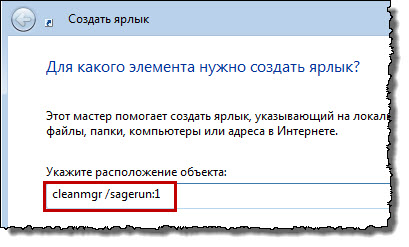
Repeat steps 1-3 for each configuration.

When you start cleaning using this command (shortcut), the program will display a window showing the progress of cleaning, but will not ask additional questions.
If you need to get access to all files - (method # 1 or # 3).
Scheduled launch
You can easily keep your HDDs tidy with automatic regular cleaning launched from the Task Scheduler.
Launch task Scheduler (Start---> All programs ---> Standard---> Service---> Task Scheduler) and press Create task:
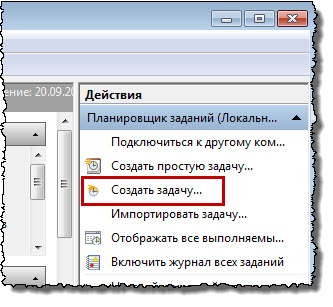
We indicate Name for a new task and check the box Execute with the highest rights:
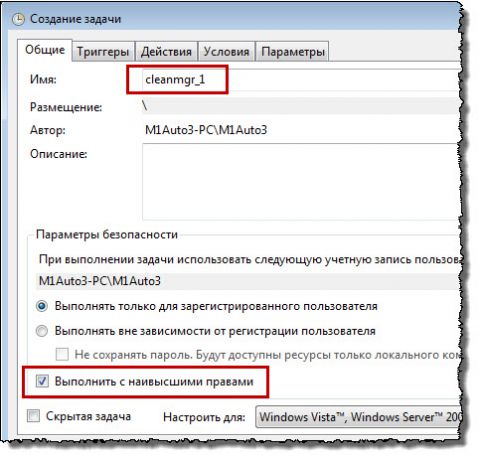
Go to the tab Triggers, press Create, set the desired cleaning interval (for example, once a week, as in the screenshot below). Push OK:

Go to the tab Actions, press Create, in the next window, click Overview:
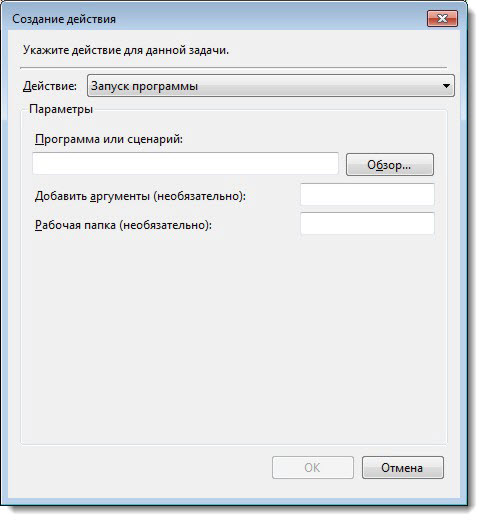
We indicate the path to
C: \ Windows \ System32 \ cleanmgr.exe
and press Open:

In field Add arguments indicate:
/ sagerun: n
where n is the configuration number specified for.
Push OK:
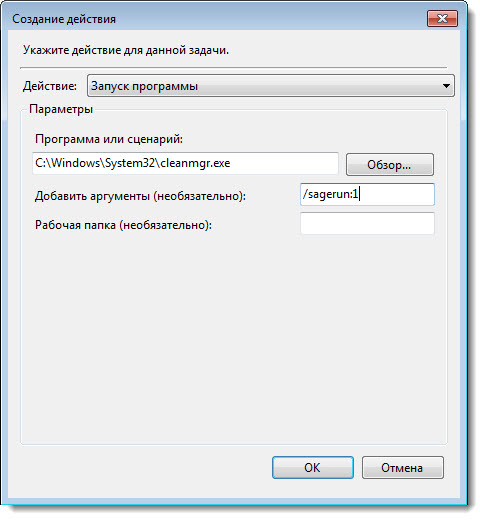
Once again OK:
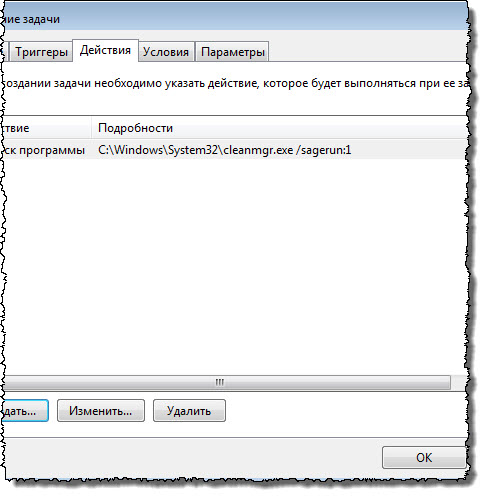
The task has been created and will perform automatic cleaning once a week (in my case). When launched, the program will display a window showing the progress of cleaning, but will not ask additional questions.
Cleanup in disk properties
The presence of a button Disk cleanup in the properties of the disk depends on the method of deleting files, which is set in the parameters of the recycle bin.

Right click on Basket and select the item Properties:
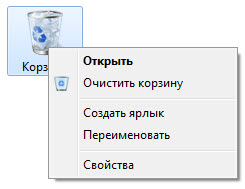
- If the item "Set size ..." is selected - the button Disk cleanup will be in the properties of the disk.
- If the item "Destroy files immediately ..." is selected, the button will not appear in the properties of the disk.

Cleanup in the context menu of the disk
To add to context menu disk item Disk cleanup use the registry tweak:
Windows Registry Editor Version 5.00 "Icon" = "cleanmgr.exe" @ = "cleanmgr.exe / d% 1"
The tweak must be added to the .reg file and imported into the registry,.

Selecting this item will start cleaning for the selected disk.
Enjoy your use!
No, we will not talk about how to disassemble your computer case and shake the dust out of its insides. Although for stationary computers with easily opened system blocks, this procedure is not only useful, but should also be carried out regularly. The more complex and functional operating systems become, the faster they fail during operation. No developer tricks help.
The complexity of the system is itself a source of problems. Modern OSs need to be cleaned of debris as often as cars are washed in bad weather.
Clean your computer from rubbish with installed Windows 7 is the same responsible and important procedure as cleaning a high-precision machine in production.
And in the same way, it is necessary to prevent clogging of the system, how to prevent dirt and dust from getting into complex optics.
OS modern computer works like a big factory. And how the plant produces a huge amount of pollution. These can be temporary files, the registry swollen from long-unnecessary keys, browser cookie and much more. Cleaning it all up by hand is impossible.
Just as it is unrealistic to sweep away the factory halls with a whisk, so it is unrealistic to remove the software waste of a modern OS without using special software.
Like the factory floor, the insides of Windows need regular inventory and sorting of everything. Fragments of files scattered throughout the hard drive do not contribute to the normal operation of Windows, deleting them is also part of our task. We will discuss the sequence of our actions to clean our computer and operating system Windows from such garbage.
Launching standard tools
As with any decent factory, Windows has its own departments responsible for cleaning the workspace. Tools that can be used to remove from the computer any useless husk that accumulates in the process of activity. The first such Windows tool is the Disk Cleaner. We type the command cleanmgr.exe in the command line, select Windows partition from the proposed list and we get something like this window:
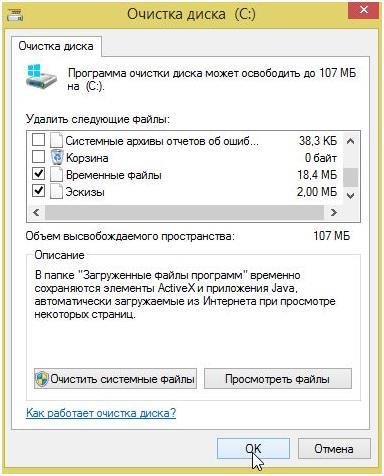 We are offered to remove very specific types of garbage from the system. Here you can put all the checkmarks, but you can only those that you like. After you click on "Ok", the computer will rustle the hard drive and try to remove all the specified types of system junk. Usually he succeeds, and the entire cleaning procedure takes no more than a few minutes. After that, our Windows will become a little cleaner, but not completely. The whole process will take a little longer, because you will need to defragment hard disk.
We are offered to remove very specific types of garbage from the system. Here you can put all the checkmarks, but you can only those that you like. After you click on "Ok", the computer will rustle the hard drive and try to remove all the specified types of system junk. Usually he succeeds, and the entire cleaning procedure takes no more than a few minutes. After that, our Windows will become a little cleaner, but not completely. The whole process will take a little longer, because you will need to defragment hard disk.
Go back to command line Windows and, this time, type: dfrgui. A window like this will appear:
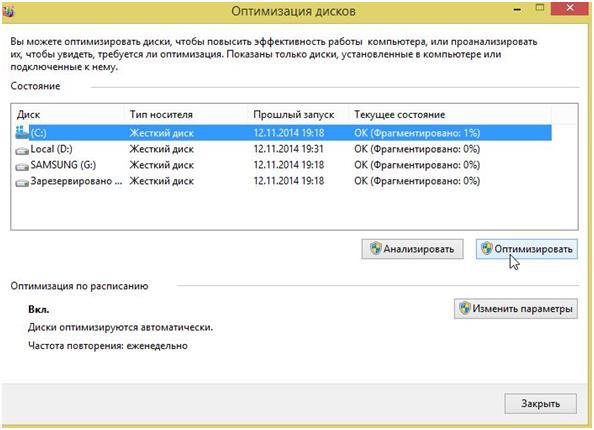 The disk data optimization utility will not prompt us to delete any data from the computer - it is able to arrange it in such a way as to increase its performance. Select a disk partition from the list and click on "Optimize"... The defragmentation procedure takes much longer than clearing temporary Windows files, so it's better to do it in your free time. But this can be done much less often.
The disk data optimization utility will not prompt us to delete any data from the computer - it is able to arrange it in such a way as to increase its performance. Select a disk partition from the list and click on "Optimize"... The defragmentation procedure takes much longer than clearing temporary Windows files, so it's better to do it in your free time. But this can be done much less often.
Assistants from the outside
Cleaning your computer is possible not only with the tools of Windows itself, but also with programs from other developers. For example, such a well-known utility as "Wise Disc Cleaner" will help to remove unnecessary things from Windows. She can do everything, the same as those discussed above. Windows tools, only makes it faster and better. The program has a nice design and is much more convenient to use than its counterparts.
Compared to built-in tools, "Wise Disc Cleaner" has expanded functionality. Using it to remove extraneous fragments from the operating system is a piece of cake. After applying it, the computer will play like a Stradivarius violin. "Wise Disc Cleaner" offers the user several levels of "polishing" the file hierarchy and a very convenient tool for defragmenting the hard disk of your computer. It is better to see once than hear a hundred times: 
Anyone who has Personal Computer... What is "cleaning" and why it is necessary to perform it, we will consider further.
Why does the computer hang?
Clogging Windows systems goes faster if the user often installs and uninstalls all kinds of programs, after the demolition of which in Windows registry there remains "garbage" accumulating exponentially. The computer starts to "slow down", which, of course, does not suit the user at all. Inexperienced PC users who have nothing on their hard drive other than useless games and dubious programs can reinstall Windows every month without losing anything. People who use the information machine for more serious purposes (work, communication) do not abuse reinstallations, so their computer can work for years without updating the system. However, unnecessary files remain and need to be deleted to extend the lifespan of the OS.
If not cleaned for a long time HDD from accumulated debris, a Windows warning may appear stating that there is not enough disk space. Unpleasant, isn't it?
This can lead to system malfunctions and even (pah-pah-pah) to its complete collapse. Which is not very pleasant, due to the loss of a lot of valuable information.
Which program is the best?
At the moment, there are a lot of cleaning programs. Such cleansing "monsters" as CCleaner, Advanced SystemCare, SpeedUpMyPC have firmly taken root in the Russian market, however, one should be careful about their choice. With an illiterate use of the "fancy" program, you can irretrievably clean up "to zero" all the information on the hard disk. People who are just getting acquainted with a computer will be quite satisfied with the program embedded in the Windows OS. Despite the simplicity of the standard utility, the volume and quality of work performed by it surpasses some specialized programs.
How to clean your Windows 7 hard drive
Disk cleaning, using a standard program, is possible with a few mouse clicks.
- Many PC "users" have this habit: to leave all the files in a row on the working Windows desktop... Movies, books, music and pictures are all mixed up. It is understandable - it is more convenient, the necessary is always at hand. But this, as a character in one film said, "is not good." Try to keep personal information NOT on the operating system disk. Clean up your desktop if possible leaving the most required shortcuts most frequently launched programs.
- Do it at least once a month. Install an automatic task scheduler that will do everything on its own.
- Never install questionable applications downloaded from suspicious sites. Believe me, they promise nothing good. And long-term cleaning of the registry from "sticky" rubbish is a dubious pleasure.
- When a lot of heat is generated, system unit, literally, attracts dust, which is also a serious reason for the "braking" of computers. Periodically opening the lid of the system unit and wiping the dusty accumulations, you can significantly speed up the speed of the PC.
Related entries:

After weeks Windows work a significant number of temporary files accumulates (application caches, leftovers from installers and remote programs, History of Internet Browsers). If you do not periodically get rid of such objects, and the size of the system disk is limited to 20-50 GB, then the operating system starts to work slower due to the fact that the files are fragmented - parts of one are in several places, or even several dozen places. The situation becomes especially deplorable when there are several hundred megabytes of free space left - the computer in such cases works very slowly.
In this article, we will figure out how to clean your computer from junk files using the example of specific programs that run on all Windows.
We use built-in OS tools
First of all, you need to use the tool offered by Windows developers - this is an OS-integrated cleaner. It works, to put it mildly, not very efficiently. You shouldn't use the built-in program to get rid of garbage all the time, but it's still better than nothing.
- Open the "Run" window by pressing Win + R.
- Enter "cleanmgr.exe" into the text line and click "OK".
Also, the command is entered in Start. Even in the same Start, you can write "cleanup" and run the "Disk Cleanup" application.
- We select the disk that we are going to free from garbage (as a rule, this is the system partition C).
- After ten seconds of scanning, a report with search results will appear.
- We mark the necessary options with the checkboxes (it is recommended to check everything with the checkboxes) and click "OK".
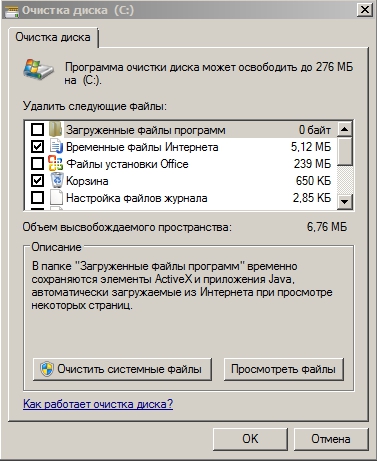
- We confirm the operation by clicking "Delete files".

As a result, the computer will be freed from several hundred gigabytes of garbage, but far from everything. For a comprehensive cleaning of temporary files, you should use specialized applications.
CCleaner
The most popular free Windows cleaner that runs on a computer with any version of the Windows operating system.
- We launch the program and put a checkmark in front of the items responsible for deleting certain data.
- If you want to remove traces of the functioning of third-party utilities (office, players, archivers), go to the "Applications" tab and note the history, cache and other traces of which programs need to be eliminated. Although initially CCleaner was configured to remove as much garbage as possible without affecting Windows files.
- We press "Analysis" and wait.
- Upon completion of the scan, the result of future cleaning will be displayed without the ability to exclude anything from the deletion list.
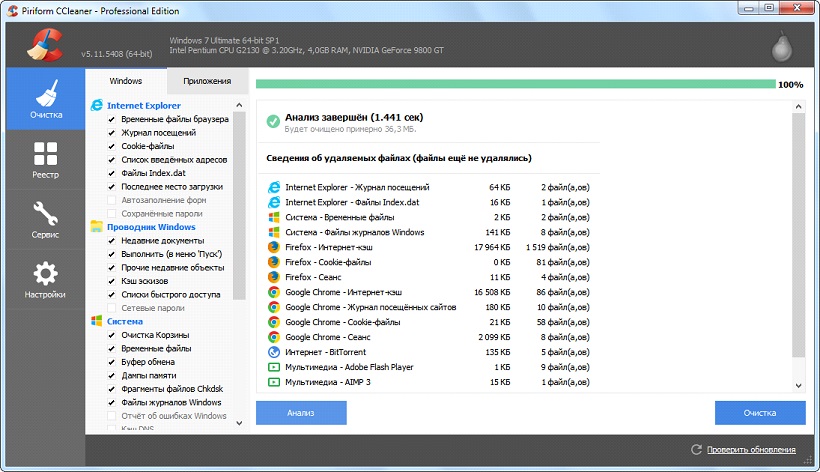
- We click "Cleanup" so that the utility erases all the garbage that the computer contains .
As well as file system clogged and system registry... CCleaner allows you to safely remove junk keys. This will reduce the size of the registry, and the speed of access to it will increase, albeit slightly.
- Go to the "Registry" tab and click "Search for problems".
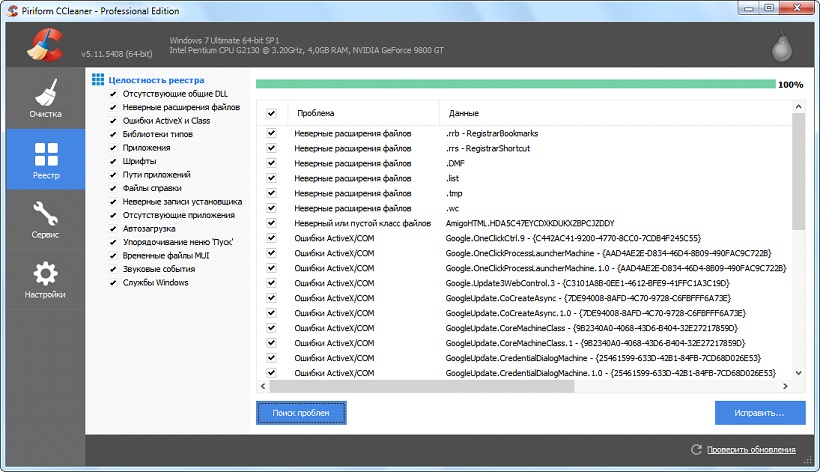
- Upon completion of the analysis, if necessary, we exclude suspicious entries from the list of deleted ones and click "Fix" in order to optimize the computer . Although this may not be done - the developers have taken care that their product does not damage Windows.
- We save backup keys to be deleted to the computer and perform cleaning by clicking on "Fix marked".
Wise Disk Cleaner
A similar application with the function of performing disk defragmentation. Working with Wise Disk Cleaner is as easy as working with CCleaner.
- We mark the categories for scanning with flags (they all unfold and contain many items for more fine-tuning the scanner).
- We press "Search".

- After receiving the results of cleaning, click on "Cleaning" to remove the debris.
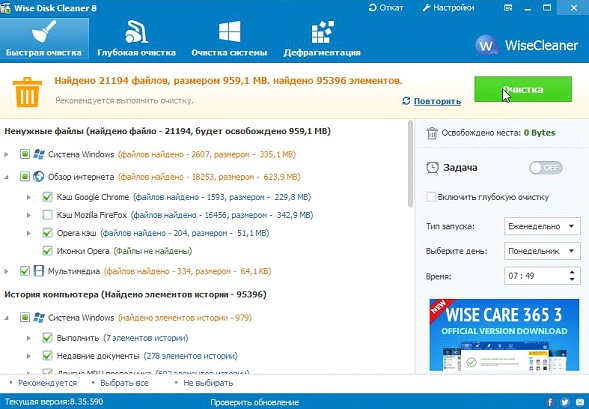
- The computer got rid of several hundred unnecessary documents.
Unlike CCleaner, you can exclude items from deletion here, such as browser passwords. You are required to check the boxes that need to be deleted and press the clear button.
Wise Registry Cleaner
Registry cleaning is also an important criterion for the speedy operation of Windows on any computer, therefore we will focus on the most popular tool for cleaning it. Although working with Registry Cleaner is no more difficult than with previous products.
- Launch the program, click "Scan", get acquainted with the results and remove the garbage.
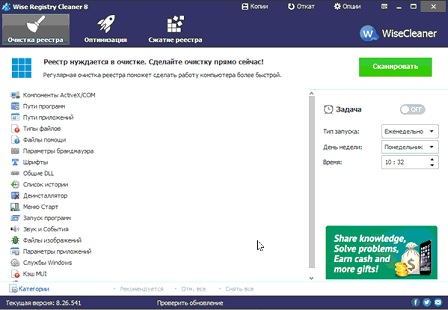
Clean master
The most popular scavenger for Android has been ported to a computer with Microsoft OS. The interface of the program, although not translated into Russian, but its operation does not raise any questions.
- We launch the application, after which it automatically scans the system.

- We look at the results, adding some applications to the exceptions forever or for the upcoming cleaning, and click "Clean now".
Exercise caution and carefully monitor the files you delete, despite high level security utility - it is still completely new and can inadvertently remove an important system or correct work program file.
(Visited 3,815 times, 2 visits today)
I bring to your attention another article from the Windows 7 heading. Today we will consider how to clean the local hard drive using the operating system itself... In addition, I will show you how to configure your operating system to periodically clean up logical partitions automatically.
Why is it necessary to clean up the disk? The answer is very simple. The operating system is something like a living being. Just get it right. This means that it is constantly in motion (dynamics): processes, services, programs are started / disabled, files are moved. Because of which a lot of unnecessary information often accumulates on the local disk (s) of a computer. Unnecessary means that the user or the operating system will no longer need it for any purpose.
A information, as we all know takes free place that you can use for your needs and purposes. In addition, the accumulation of unnecessary information on the computer can ultimately lead to unstable work.
Note that the system does not necessarily start to slow down or freeze if you do not clean the disk, it just increases the risk. Moreover, the cleaning process that allows you to delete temporary files, empty the trash, browser cache and other unnecessary information takes very little time and patience.
So why not perform this operation? And any previously unfamiliar work performed eventually becomes the experience that is so needed in our time of information technology.
But let's proceed directly to the very process of cleaning the disk..
We start the command line. To do this, open "Start" - "Run"
Rice 1 . Execute
In the command line, enter the command cleanmgr and press Enter.
A selection window will open disk for cleaning... Select the required drive (for example, the system drive C, i.e. the local drive on which the operating system is installed).
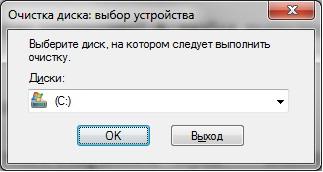
Fig 2. Selecting a disk.
The cleaning program will first perform search for files that can be deleted.
The "Disk Cleanup" window will open

Fig 3. Removal unnecessary files.
Each type of file that can be deleted has a description at the bottom. If you are not sure of your choice, I recommend reading the description first.
Go to the "Advanced" tab.
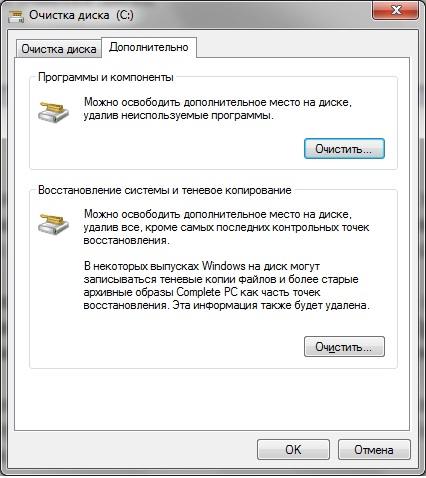
Fig 4. Additional disk cleaning.
As you can see from the figure, you can free up additional disk space in several other ways:
- by removing unused programs (section Programs and Features);
- deleting old system restore points (System Restore and Shadow Copy).
If you click on the "Cleanup" button in front of the "Programs and Features" section, a window in the control panel of the Windows 7 operating system will open under the name Programs and Features. With this application you can manually remove unused programs.
If you click on the "Cleanup" button opposite the "System Restore and Shadow Copy" section, a window will open in which you can delete restore points (if they were previously created), as well as shadow copies of files.
On the "Disk Cleanup" tab, mark which files need to be deleted. And click Ok. We confirm our choice. Will begin the process of removing unnecessary files.
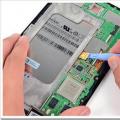 The glass on the tablet cracked - what to do?
The glass on the tablet cracked - what to do?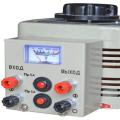 Autotransformers (latr)
Autotransformers (latr)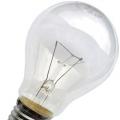 What bulbs are better to put at home What is the difference between bulbs
What bulbs are better to put at home What is the difference between bulbs